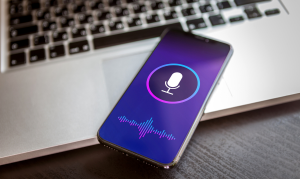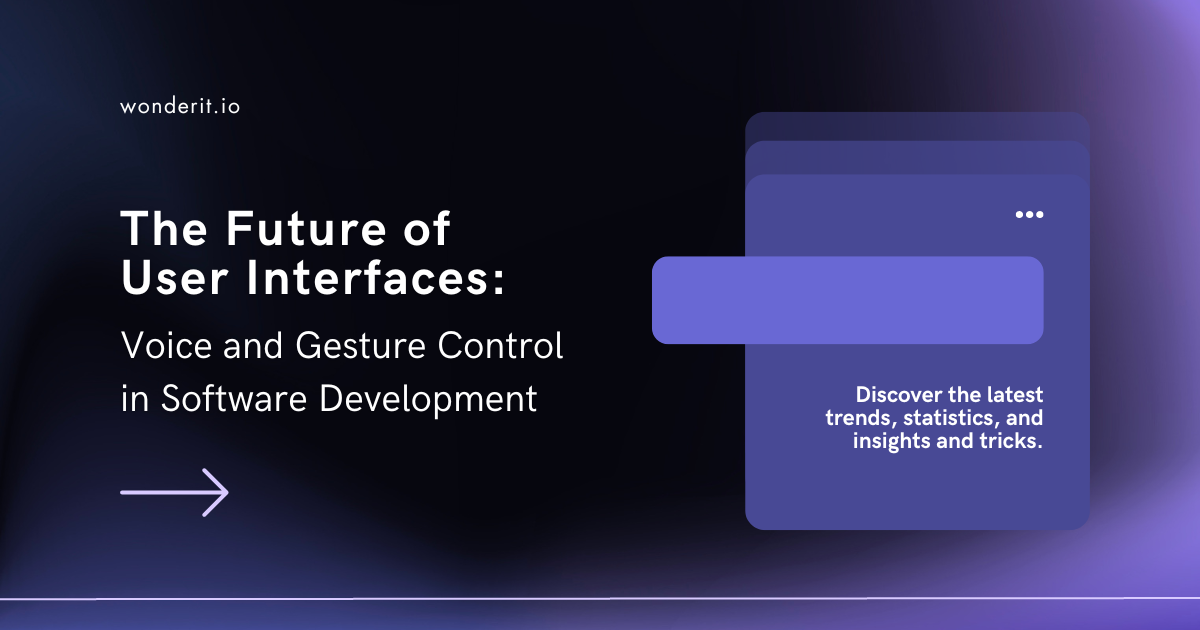Explore the exciting realm of the future of user interfaces, where voice and gesture control are reshaping software development. Discover the latest trends, statistics, and insights that highlight the transformative potential of these technologies.
In the dynamic world of software development, the concept of user interfaces has taken centre stage. As technology continues to advance at an unprecedented pace, so too does the way users interact with software. The future of user interfaces is marked by innovative approaches that enhance user experiences and streamline interactions. One such frontier is the integration of voice and gesture control into software applications. In this article, we delve into the transformative potential of these technologies and how they are shaping the future of software development.
Voice Control: A Seamless Interaction
The future of user interfaces is evolving rapidly, and voice control stands out as a game-changer in this environment. Virtual assistants like Siri, Alexa, and Google Assistant have become household names, showcasing the potential of interacting with software through natural language. This innovation has unlocked new avenues for accessibility and convenience, reshaping the way we engage with technology. A report by Juniper Research projects an astonishing growth rate, estimating that the number of voice assistants in use will surge to 8.4 billion by 2024.

Looking ahead to the future of user interfaces, voice control’s significance goes beyond simplifying interactions. It holds the key to greater inclusivity, particularly for users with disabilities who can benefit from hands-free operation. This inclusivity expands technology’s reach to a wider audience. Moreover, the ascent of smart homes and IoT devices has forged a seamless ecosystem where voice commands wield influence over various aspects of daily life. Whether it’s adjusting room temperatures or placing grocery orders, this interconnected environment underscores the transformative potential of voice control in the future of user interfaces.
Gesture Control: Redefining User Engagement
Parallel to voice control, gesture recognition technology is also making strides in reshaping the future of user interfaces. The intuitive nature of gestures closely mirrors human communication, making interactions with software feel more natural and engaging. Tech giants like Microsoft with their Kinect technology and more recently, Apple‘s incorporation of LiDAR sensors in their devices, have paved the way for gesture control innovation.

Gesture control has found applications beyond gaming and entertainment, extending its influence to various industries in shaping the future of user interfaces. Sectors like healthcare and automotive are embracing gesture interfaces to enhance precision and control in critical tasks. For instance, surgeons can manipulate digital images during procedures without physically touching a screen, thereby minimising contamination risks.
Synergy Between Voice and Gesture
While voice and gesture control offer unique benefits individually, their combination presents a synergistic interface that holds immense potential in shaping the future of user interfaces. Imagine a scenario where you’re cooking, your hands covered in flour, and you need to refer to a recipe on your tablet. A seamless interaction involving both voice commands and simple hand gestures could make the experience fluid and frustration-free.
This synergy extends to accessibility as well. Users with varying abilities can choose the interaction mode that best suits them, whether it’s issuing voice commands or using gestures. As software developers, incorporating both options ensures a more inclusive user experience.
Challenges and Considerations:
As with any emerging technology, the future of user interfaces through voice and gesture control isn’t without challenges. Accurate recognition of diverse accents, languages, and dialects remains an ongoing concern for voice control systems. Similarly, ensuring precise recognition of complex gestures without unintended triggers is a key challenge for gesture interfaces.
Furthermore, maintaining user privacy and data security is of paramount importance. Voice assistants, in particular, raise concerns about data privacy as they are always listening for activation commands. Striking a balance between convenience and privacy will be crucial in shaping the adoption of these technologies.
The Road Ahead: Navigating the Future of User Interfaces
The future of user interfaces lies in a convergence of technologies that create intuitive and personalised experiences. As voice and gesture control mature, their integration with other advancements like artificial intelligence, augmented reality, and wearables will redefine how we interact with software.
Software developers are essential in this transformation. Embracing these technologies requires a shift in design thinking, focusing on user-centric experiences that seamlessly blend the digital and physical worlds. The shift also calls for cross-disciplinary collaboration, with user experience designers, engineers, and data scientists working together to optimise interactions.
Immersive Technologies and AR/VR Interfaces
The integration of Augmented Reality (AR) and Virtual Reality (VR) is revolutionising the future of user interfaces by providing immersive experiences that go beyond traditional screens. Software developers are leveraging these technologies to create interactive 3D environments that enhance user engagement. From training simulations to virtual showrooms, AR and VR interfaces offer a new dimension to software applications, enabling users to interact with data and content in more intuitive and immersive ways.
Natural Language Processing and Voice User Interfaces (VUI)
Natural Language Processing (NLP) has made remarkable strides, enabling software to understand and respond to human language more effectively in the context of the future of user interfaces. Voice User Interfaces (VUI) are becoming increasingly prevalent, allowing users to interact with software through spoken commands and conversations. In the future, NLP advancements will lead to more accurate and context-aware interactions, bridging the gap between human communication and digital interfaces.
Gesture and Motion-Based Interfaces
Gesture recognition and motion sensing technologies are reshaping UI paradigms in the context of the future of user interfaces, enabling users to control software using body movements. From gaming to healthcare applications, gesture-based interfaces offer a new level of interactivity and accessibility. Developers are exploring ways to integrate these interfaces seamlessly, enabling users to navigate and manipulate software with simple gestures, thus reducing the reliance on physical input devices.
Minimalist and Context-Aware Design
In the context of the future of user interfaces, the future of UI design embraces minimalist principles, focusing on delivering essential information and features while eliminating clutter. Context-aware design takes this a step further by adapting the interface based on user behaviour, preferences, and environmental factors. By presenting the right information at the right time, software developers can enhance user efficiency and satisfaction, creating personalised experiences that cater to individual needs.
AI-Driven Dynamic Interfaces
Artificial Intelligence (AI) is propelling the development of dynamic interfaces that evolve in real-time in the context of the future of user interfaces, based on user interactions and data analysis. These interfaces can anticipate user needs, adapt to changing contexts, and optimise the user experience. By leveraging AI algorithms, software developers can create interfaces that learn from user behaviour, providing personalised recommendations and enhancing overall usability.
Do not miss this: AI: A game – changer for software developers
Multimodal Interfaces
In the context of the future of user interfaces, the future of UI is multi-modal, allowing users to interact with software through various sensory channels simultaneously. This includes a combination of touch, voice, gesture, and even eye-tracking interfaces. Multi-modal interfaces cater to diverse user preferences and accessibility needs, offering a more inclusive and adaptable user experience.
Conclusion: A Harmonious Digital Symphony
The future of user interfaces is a symphony of innovation, where voice and gesture control are prominent orchestrators. As we journey toward a more intuitive and accessible digital realm, these technologies promise to break down barriers and create new dimensions of engagement. The fusion of voice commands and gestures, when harnessed effectively, will enable software to adapt to human behaviour, making technology an extension of ourselves rather than a separate entity. The future beckons, and it’s a harmonious duet between humans and technology.


Recent Comments